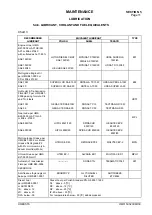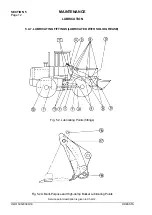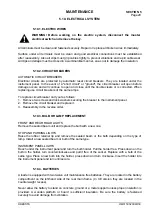
SECTION 5
MAINTENANCE
Page 22
OM515C520C99/1E
DRESSTA
BRAKES
5. Inspect the parking brake. If service is necessary, consult your distributor (the minimal brake
shoes thickness is 4 [mm]).
6. After the deficiencies have been corrected, recheck the system by repeating steps 1 thru 3.
WARNING! After operating a machine in poor conditions (mire, clay), to avoid
penetration of dirt into the parking brake, which can cause deterioration of
braking capability), wash the brake with water and dry it with compressed air. If
the brake has been soiled, clean all metal parts, coat the latches with Litomos
EP-23 grease (or equivalent, refer to chart 2, section 5.4).
5.8. COOLING SYSTEM
GENERAL
The cooling system operates under pressure which is controlled by the pressure relief valve in the
radiator cap.
The belt driven water pump circulates the coolant through the engine block, cylinder heads, radiator,
and engine oil cooler. In the radiator bottom tank there is an oil cooler which cools the transmission
oil (Fig. 6.3). Machines in EC configuration are equipped with another “oil-air” type transmission oil
cooler connected serially with the standard oil cooler. This additional cooler is mounted on the
standard cooler housing at the rear of the machine coolant. Circulation is controlled by the
thermostat which by-passes coolant flow around the radiator until the engine reaches operating
temperature.
Proper cooling is possible only when the system is sealed, the radiator cap gasket is in good
condition, the pressure relief valve and thermostats are operating properly, the system is free of
coolant and air flow restrictions and is filled to the proper level.
Selection and maintenance of the engine coolant is important to long engine life. The following
information provides recommendations for selecting the engine coolant, maintaining the coolant
inhibitors and servicing the cooling system.
The system operates successfully with a water/antifreeze mixture of inhibited/conditioned water as
the coolant. Water alone allows rust, scale deposits, and corrosion to occur within the system.
5.8.1. WATER
Use water which has a low mineral content. Water used in conjunction with antifreeze, coolant
filters and inhibited water must meet the following standards:
Total hardness:
Not to exceed 170 parts per million to prevent scale deposits. Water containing
dissolved magnesium and calcium (the usual reason for water hardness) above the specified
amount will cause scale deposits to develop in the engine.
Chlorides
- Not to exceed 100 parts per million to prevent corrosion.
Dissolved solids
- Not to exceed 340 parts per million to minimize sludge deposits, scale deposits
and corrosion.
If any of the requirements cannot be met, use distilled, de-ionized or de-mineralized water. To
determine if the local water supplies meet these standards, water samples can be tested by water
treatment laboratories. Softened water that is prepared using common salt (sodium chloride)
contains excessive amounts of chlorides and should not be used.
Summary of Contents for 515C
Page 3: ...OM515C520C99 1E DRESSTA ...
Page 5: ......
Page 7: ......
Page 10: ...SECTION 1 INTRODUCTION ...
Page 12: ......
Page 17: ...SECTION 2 SAFETY PRECAUTIONS ...
Page 19: ......
Page 37: ...SECTION 3 MACHINE TRANSPORT AND STORAGE ...
Page 39: ......
Page 49: ...SECTION 4 OPERATING ...
Page 51: ......
Page 107: ...SECTION 5 MAINTENANCE ...
Page 165: ...SECTION 6 SPECIFICATIONS ...
Page 167: ......
Page 181: ...SECTION 6 SPECIFICATIONS Page 16 OM515C520C99 1E DRESSTA WIRING DIAGRAMS ...
Page 182: ...SPECIFICATIONS SECTION 6 Page 17 DRESSTA OM515C520C99 1E WIRING DIAGRAMS ...
Page 187: ...SECTION 6 SPECIFICATIONS Page 22 OM515C520C99 1E DRESSTA WIRING DIAGRAMS ...






























